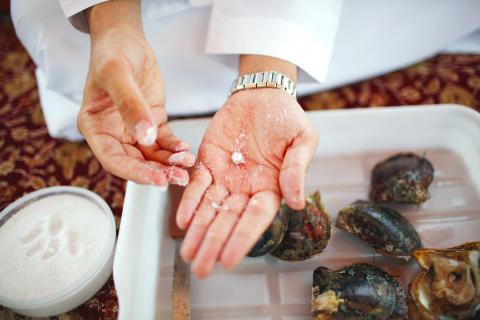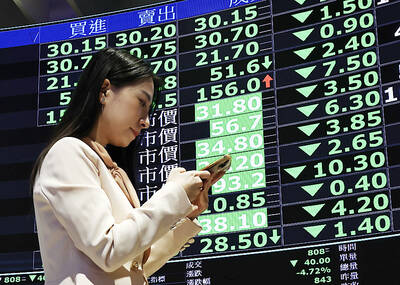Abdulla al-Suwaidi dreamed of reviving a long-lost part of Middle Eastern culture when he seeded his first oyster with a tiny bead and placed it in the warm waters of the Gulf in 2004.
Almost a decade later, the cofounder and vice-chairman of RAK Pearls is finally seeing the fruits of his labor with the first auction of cultured pearls from RAK’s oyster farm off the coast of Ras al-Khaimah, one of seven emirates that make up the United Arab Emirates.
“We’re seeing today a revival of a culture, a treasure that’s been lost to us for many, many years,” al-Suwaidi said in an interview.

Photo: Reuters
Natural pearl diving was once the main income of many families in the region, but it vanished after World War I with the development of vast oil reserves in the Gulf and the rise of competition from Japanese cultured pearls.
RAK Pearls, the region’s only cultured pearl producer, now has about 40,000 oysters bedded down in the Gulf’s briny waters and in June, the Dubai Multi Commodities Centre Authority (DMCC) held an exclusive auction for some of its produce.
“Dubai has been a trading center of pearls for many years, but this is the first time that we auction locally cultivated pearls with a quality that surpasses anything that you’ve seen farmed in countries like China and Japan,” DMCC executive vice chairman Ahmed bin Sulayem said.

Photo: Reuters
The value of traded natural and cultured pearls through nearby Dubai grew by an average 25 percent annually between 2003 and 2011 to hit US$30 million a year in the past few years, while volumes have risen 10 percent annually, DMCC director of commodity services Franco Bosoni said.
Prices per pearl could hit as much as 1 million UAE dirhams (US$272,300), RAK’s Japanese board director Daiji Imura said. Smaller pearls could sell for as little as 1 dirham.
Historically, natural pearls were symbols of style and an important indicator of wealth and status in the Middle East.
Until the decline of the natural pearl market, local fishermen throughout the Gulf used to dive deep into the waterway’s warm waters, hunting for the pearls which provided a main source of income for many people.
The Gulf has produced fine jewelry for thousands of years, and the best natural pearls appeared in the jewelry of kings and queens.
RAK Pearls intends to grows its production of 40,000 oysters to about 200,000 in a few years, but considers it more than just a business.
“Pearls are mentioned in our poems, books and even the names of our daughters,” al-Suwaidi said.
His firm has adopted the Japanese pearl farming technology of inserting tiny beads made from mother of pearl into oysters along with a small piece of the mantle organ from a donor oyster.
The mollusk then naturally coats the bead with layers of a substance called nacre — the same hard, iridescent material that lines its inner shell and is known as mother of pearl.
The oyster is then placed back in the water and over several months, the buildup of nacre layers eventually creates what is known as a cultured pearl.
Holding tweezers and a small sharp blade, RAK’s pearl-seeding expert Lutfi Hasayed treats the oysters with the loving care of a doctor and the sharp eye of an artist.
“Success at our farm is 80 percent,” Hasayed said from his air-conditioned workspace near the turquoise waters.
That is just as well, as the project is partly owned by the government of Ras al-Khaimah and expected to become part of the tourist trail as well as contribute to the food industry.
Waste from the shells is used as fertilizer and the oyster meat is served at the company’s Japanese restaurant chain in the emirate.
“This is a pilot project and we’re receiving interest from investors across the region to duplicate it in other countries,” RAK marketing manager Mohammed al-Suwaidi said.
“We plan to bring the pearling industry of the Gulf back to its golden days,” he said.

TARIFFS: The global ‘panic atmosphere remains strong,’ and foreign investors have continued to sell their holdings since the start of the year, the Ministry of Finance said The government yesterday authorized the activation of its NT$500 billion (US$15.15 billion) National Stabilization Fund (NSF) to prop up the local stock market after two days of sharp falls in reaction to US President Donald Trump’s new import tariffs. The Ministry of Finance said in a statement after the market close that the steering committee of the fund had been given the go-ahead to intervene in the market to bolster Taiwanese shares in a time of crisis. The fund has been authorized to use its assets “to carry out market stabilization tasks as appropriate to maintain the stability of Taiwan’s

STEEP DECLINE: Yesterday’s drop was the third-steepest in its history, the steepest being Monday’s drop in the wake of the tariff announcement on Wednesday last week Taiwanese stocks continued their heavy sell-off yesterday, as concerns over US tariffs and unwinding of leveraged bets weighed on the market. The benchmark TAIEX plunged 1,068.19 points, or 5.79 percent, to 17,391.76, notching the biggest drop among Asian peers as it hit a 15-month low. The decline came even after the government on late Tuesday authorized the NT$500 billion (US$15.2 billion) National Stabilization Fund (國安基金) to step in to buoy the market amid investors’ worries over tariffs imposed by US President Donald Trump. Yesterday’s decline was the third-steepest in its history, trailing only the declines of 2,065.87 points on Monday and

TARIFF CONCERNS: The chipmaker cited global uncertainty from US tariffs and a weakening economic outlook, but said its Singapore expansion remains on track Vanguard International Semiconductor Corp (世界先進), a foundry service provider specializing in producing power management and display driver chips, yesterday withdrew its full-year revenue projection of moderate growth for this year, as escalating US tariff tensions raised uncertainty and concern about a potential economic recession. The Hsinchu-based chipmaker in February said revenues this year would grow mildly from last year based on improving supply chain inventory levels and market demand. At the time, it also anticipated gradual quarter revenue growth. However, the US’ sweeping tariff policy has upended the industry’s supply chains and weakened economic prospects for the world economy, it said. “Now

Six years ago, LVMH’s billionaire CEO Bernard Arnault and US President Donald Trump cut the blue ribbon on a factory in rural Texas that would make designer handbags for Louis Vuitton, one of the world’s best-known luxury brands. However, since the high-profile opening, the factory has faced a host of problems limiting production, 11 former Louis Vuitton employees said. The site has consistently ranked among the worst-performing for Louis Vuitton globally, “significantly” underperforming other facilities, said three former Louis Vuitton workers and a senior industry source, who cited internal rankings shared with staff. The plant’s problems — which have not